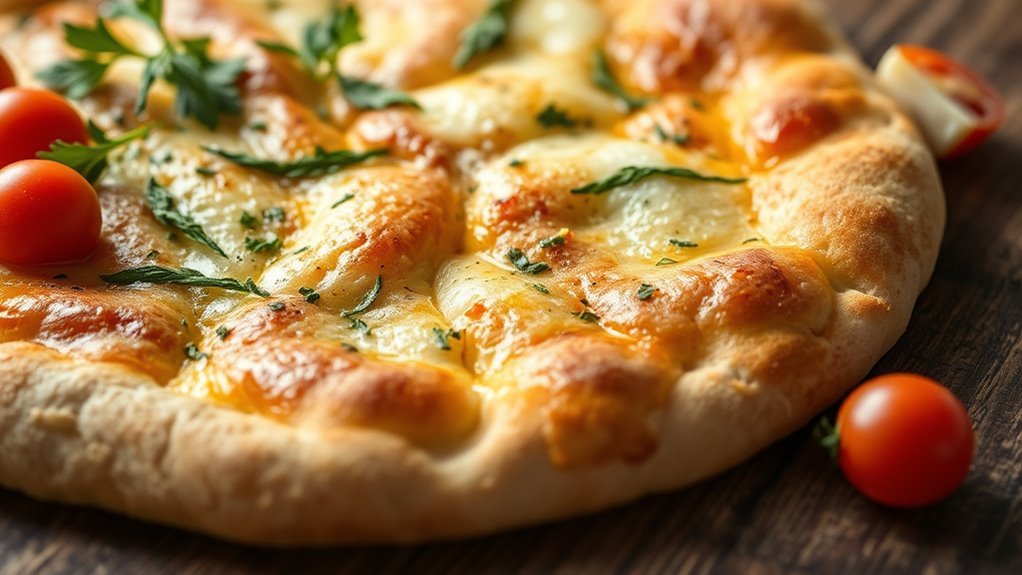While many gluten-free crusts aren’t keto-friendly due to higher carb content, you can find or make options that fit both diets. Ingredients like almond flour and cauliflower are low in carbs and gluten-free, making them ideal choices. Always check labels for nutritional information, as some gluten-free products can still be high in sugars. If you’re looking for ways to enjoy pizza without compromising your diet, there are plenty of tasty alternatives to explore further.
Understanding the Keto Diet

The ketogenic diet, often referred to as keto, typically involves a significant reduction in carbohydrate intake, generally to about 5-10% of total daily calories. This approach aligns with keto principles, focusing on high-fat and moderate-protein consumption, allowing your body to enter a state of ketosis. In ketosis, your body becomes efficient at burning fat for energy, rather than relying on carbs. Low carb living can provide numerous benefits, including weight loss, improved mental clarity, and stable energy levels. However, it’s crucial to balance your nutrient intake to guarantee you’re meeting your body’s needs. If you’re considering adopting this lifestyle, understanding the fundamentals of the keto diet can empower you to make informed choices that enhance your freedom in food selection.
What Is Gluten-Free?

Gluten-free refers to foods that do not contain gluten, a protein found in wheat, barley, and rye. Many people choose gluten-free options due to potential gluten sensitivity or celiac disease. The gluten free benefits include improved digestion, increased energy, and reduced inflammation for those with sensitivities. However, it’s essential to address gluten free misconceptions—that all gluten-free foods are inherently healthier or suitable for everyone. Not all gluten-free products are nutritious; some can be high in sugars and fats. Understanding what gluten-free truly means allows you to make informed choices. Ultimately, whether you’re seeking to improve health or explore new dietary options, knowing the facts about gluten-free choices empowers you to enjoy your meals without compromise.
Common Gluten-Free Crust Ingredients

Many people exploring gluten-free options often turn to crusts made from alternative ingredients. Common ingredients include almond flour, coconut flour, and cauliflower, each offering unique nutritional benefits. Almond flour is high in protein and healthy fats, making it a popular choice for those with dietary restrictions. Coconut flour, rich in fiber, can help with digestion and satiety. Cauliflower, when riced or mashed, provides a low-carb base that’s versatile and nutrient-dense. These alternatives can cater to various dietary needs while still satisfying cravings. However, it’s essential to evaluate how these ingredients fit into your overall diet, especially if you’re also looking to maintain a keto lifestyle. Balancing taste and nutrition is key in your gluten-free journey.
Analyzing Carbohydrate Content
While exploring gluten-free crust options, it’s vital to analyze their carbohydrate content, especially if you’re aiming for a ketogenic lifestyle. Many gluten-free crusts rely on alternative carbohydrate sources, such as rice flour, almond flour, or tapioca starch. These ingredients often contain higher carb levels than traditional wheat crusts, which can hinder your keto goals. If you have gluten sensitivity, you might lean toward these gluten-free options, but be cautious about the total carb count. Always check labels for nutritional information to make sure you’re staying within your carb limits. Balancing your cravings with your dietary needs is important, so choose wisely to enjoy freedom in your diet without compromising your keto commitment.
Gluten-Free Crust Alternatives for Keto
When you’re looking for gluten-free crust alternatives on a keto diet, almond flour and cauliflower crusts are popular options. Almond flour provides a low-carb base rich in healthy fats, while cauliflower crust offers a vegetable-forward choice that’s also low in carbs. Both alternatives can help you enjoy your favorite dishes without compromising your dietary goals.
Almond Flour Crust
Almond flour crust offers a delicious and versatile alternative for those following a gluten-free and ketogenic diet. Rich in healthy fats and low in carbs, almond flour provides numerous almond benefits, including essential vitamins and minerals. This crust can be used for pizzas, quiches, or even tarts, allowing for various crust variations to suit your taste preferences. You can easily customize it with herbs and spices, enhancing its flavor without compromising your diet. Plus, almond flour has a satisfying texture that mimics traditional flour, so you won’t feel deprived. By incorporating almond flour crust into your meals, you can enjoy your favorite dishes while maintaining your keto lifestyle, embracing the freedom of choice in your culinary adventures.
Cauliflower Crust Options
Another popular option for those on a gluten-free and ketogenic diet is cauliflower crust. This alternative not only caters to your dietary needs but also offers impressive cauliflower nutrition. Cauliflower is low in carbohydrates, high in fiber, and packed with vitamins, making it an excellent choice for a keto lifestyle. Its crust versatility allows you to explore various flavors and toppings while keeping your meals exciting. Here’s a quick comparison of popular cauliflower crust options:
| Type | Carbs per Serving |
|---|---|
| Store-bought | 5g |
| Homemade | 3g |
| Cauliflower Pizza | 4g |
| Cauliflower Flatbread | 2g |
Experimenting with cauliflower crust can help you enjoy satisfying meals without sacrificing your goals.
Popular Gluten-Free Crust Brands
When exploring gluten-free crust options, you’ll find several popular brands that cater to different tastes and dietary needs. It’s important to compare their nutritional profiles and flavor characteristics to determine which one suits your preferences best. By understanding these factors, you can make a more informed choice that aligns with your keto goals.
Top Gluten-Free Brands
With a growing demand for gluten-free options, several brands have emerged as leaders in the market, offering a variety of gluten-free crusts that cater to different tastes and dietary needs. When you look at brand comparisons, some names stand out, such as Caulipower, which uses cauliflower for a unique texture, and Against the Grain, known for its cheese-filled crusts. Both prioritize quality ingredient sourcing, ensuring you get a product that aligns with your dietary choices. Another remarkable contender is Udi’s, which offers a more traditional pizza crust experience. Each brand has its strengths, so exploring these options can help you find a gluten-free crust that fits your lifestyle without sacrificing flavor or texture.
Nutritional Comparisons
As you consider gluten-free options, it’s essential to examine the nutritional profiles of popular brands to find one that meets your dietary needs. Many gluten-free crusts offer varying nutritional benefits, but they can differ greatly in carbohydrate content and fiber levels. For instance, some brands utilize almond flour, which is lower in carbs and richer in healthy fats compared to traditional crusts. Ingredient sourcing also plays an important role; opting for brands that prioritize whole, non-GMO ingredients can enhance your overall nutrition. Additionally, be mindful of added sugars and preservatives, as these can undermine the healthiness of a gluten-free crust. By comparing these factors, you’ll be better equipped to choose a crust that aligns with your ketogenic or gluten-free lifestyle.
Flavor Profiles Explained
While gluten-free crusts can vary greatly in flavor, many popular brands aim to replicate the taste and texture of traditional options. You’ll find that some brands focus on unique flavor combinations, like almond and coconut, offering a subtly sweet base. Others, such as cauliflower crusts, provide a savory option with a hint of earthiness. Texture variations also play an essential role; some crusts are crispy, while others are chewy, catering to different preferences. Significantly, brands like Caulipower and Against the Grain have garnered attention for balancing flavor and texture, making them appealing choices for those seeking gluten-free options. Ultimately, your choice may depend on your taste preferences and dietary needs, allowing for enjoyable pizza experiences without gluten.
Tips for Making Keto-Friendly Gluten-Free Crust
To create a delicious keto-friendly gluten-free crust, it’s essential to choose the right ingredients that align with both dietary restrictions. Start with almond flour or coconut flour as your base; they’re lower in carbs and gluten-free, making them perfect for keto baking. You might also consider using ground flaxseed or chia seeds for added fiber and texture.
For crust variations, incorporate herbs or spices to enhance flavor, or use cheese for a crispy edge. Always check labels for added sugars or hidden carbs in any ingredients. Don’t forget to experiment with different ratios to find the perfect consistency. With these tips, you can enjoy a satisfying crust that meets your dietary needs without sacrificing taste or texture.
Balancing Gluten-Free and Keto Diets
Balancing a gluten-free diet with keto principles can be challenging, yet it’s entirely achievable with the right approach. To navigate these dietary restrictions, focus on low-carb, gluten-free ingredients like almond flour, coconut flour, and flaxseeds. These alternatives not only keep your carb intake in check but also add nutritional value. When adapting recipes, consider substituting traditional high-carb elements with keto-friendly options, ensuring you maintain flavor and satisfaction. For instance, using cauliflower for pizza crust can be a delicious and compliant choice. Remember, it’s important to stay informed and flexible, experimenting with various recipe adaptations until you find what works best for you. With creativity, you can enjoy a diverse menu while adhering to both gluten-free and keto diets.
Frequently Asked Questions
Can I Eat Gluten-Free Bread on a Keto Diet?
You might think gluten-free bread is the ultimate solution for your keto cravings, but irony strikes when you realize it often contains more carbs than traditional options. While you do have gluten-free options, many still don’t align with keto restrictions. If you’re serious about keeping your carb intake low, it’s best to check the labels. Stick to low-carb alternatives like almond flour bread to truly enjoy your keto journey with freedom.
What Are Some Keto-Friendly Gluten Substitutes?
If you’re looking for keto-friendly gluten substitutes, almond flour and coconut flour are excellent options. Almond flour is low in carbs and high in healthy fats, making it a great base for baked goods. Coconut flour, while more absorbent, is also low in carbs and adds a unique flavor. Both can help satisfy your cravings without kicking you out of ketosis, giving you the freedom to enjoy delicious meals without gluten guilt.
Are Gluten-Free Crusts Always Low in Carbs?
Imagine wandering through a garden of gluten alternatives, each promising a delightful escape from traditional crusts. However, not all gluten-free crusts are low in carbs. Some might be made from rice flour or other high-carb ingredients, which can still pack a hefty carb content. It’s essential to read labels and choose wisely if you’re aiming for a low-carb lifestyle. Just because it’s gluten-free doesn’t mean it’s always a keto-friendly option!
How Do I Know if a Crust Is Keto-Approved?
To know if a crust is keto-approved, you’ll need to check the nutritional labels carefully. Look for low net carbs—ideally under 5 grams per serving. Carb counting is essential on a keto diet, so pay attention to fiber and sugar alcohols that can affect the total carb count. Don’t hesitate to research the ingredients; those made from almond flour or cauliflower are often better choices for keeping your carb intake in check.
Is There a Difference Between Gluten-Free and Keto-Friendly?
Yes, there’s a difference between gluten-free and keto-friendly. Gluten-free options are designed for those with gluten sensitivity, removing wheat and related grains. However, they can still be high in carbs, which isn’t ideal for a keto diet. Keto-friendly foods focus on low carb content, often emphasizing healthy fats and proteins instead. So, while a gluten-free crust might be safe for some, it may not meet your keto needs. Always check the labels!


